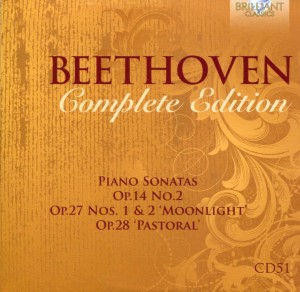 I was hooked – hooked! – from the first notes of today’s CD.
I was hooked – hooked! – from the first notes of today’s CD.
It just has that indefinable, magical quality I like in my piano sonatas.
Plus, it has the incomparable Alfred Brendel tickling the ivories.
Did I just type that?
Do Classical pianists tickle anything, let alone ivories?
And, for that matter, are piano keys made of ivory?
Whatever.
Today’s piano sonatas are superb. This immediately became one of my favorite Beethoven Piano Sonata CDs.
Here’s what I am listening to today:
Beethoven Piano Sonata No. 10 in G Op. 14 No. 2
According to its entry on Wikipedia:
The Piano Sonata No. 10 in G major, Op. 14, No. 2, composed in 1798–1799, is an early-period work by Ludwig van Beethoven, dedicated to Baroness Josefa von Braun. A typical performance lasts 15 minutes. While it is not as well known as some of the more original sonatas of Beethoven’s youth, such as the ‘Pathétique’ or ‘Moonlight’ sonatas, Tovey[1] described it as an ‘exquisite little work.’
Beethoven was 28-29 when he composed this piece.
Beethoven Piano Sonata No. 13 in E Flat Op. 27 No. 1
According to its entry on Wiki:
Piano Sonata No. 13 in E-flat major “Quasi una fantasia”, Op. 27, No. 1, is a sonata composed by Ludwig van Beethoven in 1800–1801.
Beethoven was about 30 years old when he wrote the sonata. He had already made a name for himself in Vienna as pianist and composer and was beginning to explore alternatives to the classical-era compositional procedures that he had largely adhered to during the 18th century. The most famous works of his “middle period”, often emphasizing heroism, were yet to come.
Beethoven’s sketches for the first, second, and final movements survive, but the original autograph copy is lost. The sonata was published separately from its more famous companion, Opus. 27 No. 2 (the so-called “Moonlight” Sonata), but at the same time, by Cappi in Vienna; the first advertisements for the work appeared 3 March 1802. Both Op. 27 sonatas were originally titled Sonata quasi una fantasia.
The dedicatee of the work was (as was typical of the time) an aristocrat, Princess Josephine von Liechtenstein. Little is known of Beethoven’s relationship with her.
Beethoven Piano Sonata No. 14 in C Sharp Minor Op. 27 No. 2 “Moonlight”
As I wrote at the outset, the opening notes of Piano Sonata No. 10 in G Op. 13 No. 2 drew me in to today’s CD. Movement I (“Andante – Allegro – Andante”) of Piano Sonata no 13 in E Flat Op. 27 No. 1 sweetened the deal.
But the main reason why Continue reading
